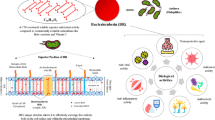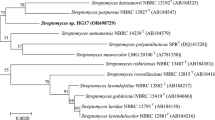Abstract
An isolate of Streptomyces decoyicus M* (code of the isolate) was identified by the sequencing of 16S rRNA gene. It was grown on solid media and secondary metabolites were extracted with n-butanol. The extract was dried and run in a sodium dodecyl sulphate–polyacrylamide gel (SDS–PAGE, 10%). Two main bands obtained were sliced and the metabolites were regained in n-butanol. These two samples were then identified by gas-chromatography–mass spectrometry (GC–MS), and Fourier-transform infrared spectroscopy (FT-IR). The results demonstrated that tromethamine- and 1-dodecanol were the main constituents (band 1: 61% and 17.7%; band 2: 41% and 54%, respectively). This finding maintained that the isolate of Streptomyces decoyicus produced high amounts tromethamine- and 1-dodecanol under the conditions investigated.





Similar content being viewed by others
References
Berdy J (1995) Are Actinomycetes exhausted as a source of secondary metabolites? Russian Biotechnol Biotekhnol 7:3–23
Berdy J (2012) Thoughts and facts about antibiotics: where we are now and where we are heading. J Antibiot 65:385–395
Besson G, Drits VA (1997) Refined relationships between chemical composition of dioctahedral fine-grained mica minerals and their infrared spectra within the OH stretching region. Part I: identification of the OH stretching bands. Clays Clay Miner 45:158–169
Bundale S, Begde D, Pillai D, Gangwani K, Nashikkar N, Kadam K, Upadhyay A (2018) Novel aromatic polyketides from soil Streptomyces spp.: purification, characterization and bioactivity studies. World J Microbiol Biotechnol 34:67
Camacho C, Coulouris G, Avagyan V, Ma N, Papadopoulos J, Bealer K, Madden TL (2009) BLAST plus: architecture and applications. BMC Bioinf 10:421
Chaudhary H, Gopalan N, Shrivastava A, Singh S, Singh A, Yadav J (2013) Antibacterial activity of actinomycetes isolated from different soil samples of Sheopur (A city of central India). J Adv Pharm Technol Res 4:118–123
Çetinkaya S (2021) A novel isolate (S15) of Streptomyces griseobrunneus produces 1-dodecanol. Curr Microbiol 78:144–149
Çetinkaya S, Yenidünya AF, Aksu A, Çelik MS (2021) Purification and characterisation of 1-dodecanol from an isolate of Streptomyces viridodiastaticus. Biocatal Agric Biotechnol 34:1
Dewi TK, Dwi A, Antonius S (2017) Secondary metabolites production by actinomycetes and their antifungal activity. ICBS conference proceedings, international conference on biological science KnE. Life Sci 3:256–264
Dror B, Jurkevitch E, Cytryn E (2020) State-of-the-art methodologies toidentify antimicrobial secondary metabolites in soil bacterial communities-a review. Soil Biol Biochem 147:107838–107847
Elmallah MIY, Cogo S, Constantinescu A, Esposito SE, Abdelfattah MS, Micheau O (2020) Marine actinomycetes-derived secondary metabolites overcome TRAIL-resistance via the intrinsic pathway through down regulation of survive in and XIAP. Cells 9:1760–1778
Erdik E (2008) Organik Kimyada Spektroskopik Yöntemler. Gazi Kitabevi, Ankara, pp 118–152
Goodfellow M, Simpson KE (1987) Ecology of streptomyces. Front Appl Microbiol 2:97–125
Jensen PR, Williams PG, Oh DC, Zeigler L, Fenical W (2007) Speciesspecific secondary metabolite production in marine actinomycetes of the genus Salinispora. Appl Environ Microbiol 73:1146–1152
Katoh K, Asimenos G, Toh H (2009) Multiple alignment of DNA sequences with MAFFT. Methods Mol Biol 537:39–64
Khattab AI, Babiker EH, Saeed HA (2016) Streptomyces: isolation, optimization of culture conditions and extraction of secondary metabolites. Int Curr Pharmaceut J 5:27–32
Kimura M (1980) A simple method for estimating evolutionary rates of base substitutions through comparative studies of nucleotide sequences. J Mol Evol 16:111–120
Klindworth A, Pruesse E, Schweer T, Peplles J, Quast C, Horn M, Glökner FO (2013) Evaluation of general 16S ribosomal RNA gene PCR primers for classical and next-generation sequencing-based diversity studies. Nucleic Acids Res 41:e1
Lunt D (2017) HotSHOT DNA extraction. protocols.io. https://doi.org/10.17504/protocols.io.g6vbze6
Manivasagan P, Venkatesan J, Sivakumar K, Kim SK (2013) Marine actinobacterial metabolites: current status and future perspectives. Microbiol Res 168:311–332
Mincer TJ, Jensen PR, Kauffman CA, Fenical W (2002) Widespread and persistent populations of a major new marine actinomycete taxon in ocean sediments. Appl Environ Microbiol 68(10):5005–5011
Mohan KD, Rajamanickam U (2018) Biodiversity of actinomycetes and secondary metabolites. Inn Orig Inter J Sci 5:21–27
Nayaka S, Nagaraja SK, Chakraborty B, Bhat MP, Swamy PS, Airodagi D, Hiremath H, Rudrappa M, Basavarajappa DS, Pednekar AR (2020) Antimicrobial and enzymatic potential of Streptomyces sp. KAS-1 isolated from the microbiologically unexplored estuary of Kali river ecosystem. Int J Res Pharm Sci 11(2):1655–1666
Pathalam G, Rajendran HAD, Appadurai DR, Gandhi MR, Michael GP, Savarimuthu I, Naifabdulla A (2017) Isolation and molecular characterization of Actinomycetes with antimicrobial and mosquito larvicidal properties. Beni-Suef Univ J Basic Appl Sci 6:209–217
Ramesh S, Rajesh M, Mathivanan N (2009) Characterization of a thermostable alkaline protease produced by marine Streptomyces fungicidicus MML1614. Bioprocess Biosyst Eng 32:791–800
Selim MSM, Abdelhamid SA, Mohamed SS (2021) Secondary metabolites and biodiversity of actinomycetes. J Genet Eng Biotechnol 19:1–13
Tamura K, Stecher G, Peterson D, Filipski A, Kumar S (2013) MEGA6: Molecular evolutionary genetics analysis version 6.0. Mol Biol Evol 30:2725–2729
Thirumurugan D, Vijayakumar R, Vadivalagan C, Karthika P, AlamKhane K (2018) Isolation, structure elucidation and antibacterial activity of methyl-4,8-dimethylundecanate from the marine actinobacterium Streptomyces albogriseolus ECR64. Microb Pathog 121:166–172
Usha Nandhini S, Sudha S, Anusha JV, Manisha S (2018) Isolation, Identification and Extraction of antimicrobial compounds produced by Streptomyces sp. from terrestrial soil. Biocatal Agric Biotechnol 5:317–321
Valli S, Sugasini SS, Aysha OS, Nirmala P, Vinoth Kumar P, Reena A (2012) Antimicrobial potential of actinomycetes species isolated from marine environment. Asian Pac J Trop Biomed 2:469–473
Vimal V, Rajam BM, Kannnabiran K (2009) Antimicrobial activity of marine actinomycetes, Nocardiopsis sp. VITSVK 5 (FJ973467). Asian J. Med. Sci. 5:57–63
Funding
The study was funded by the Sivas Cumhuriyet University Scientific Research Projects, Turkey (No. F-2021-639).
Author information
Authors and Affiliations
Corresponding author
Ethics declarations
Conflict of interest
The authors declare that they have no conflict of interests.
Research involving human and animal rights
This article does not contain any studies involving animals performed by any of the authors.
Additional information
Communicated by Erko Stackebrandt.
Publisher's Note
Springer Nature remains neutral with regard to jurisdictional claims in published maps and institutional affiliations.
Supplementary Information
Below is the link to the electronic supplementary material.
Rights and permissions
About this article
Cite this article
Çelik, M.S., Aksu, A., Yenidünya, A.F. et al. Tromethamine and dodecanol appear to be the major secondary metabolites of Streptomyces decoyicus M*. Arch Microbiol 204, 456 (2022). https://doi.org/10.1007/s00203-022-03076-5
Received:
Revised:
Accepted:
Published:
DOI: https://doi.org/10.1007/s00203-022-03076-5




